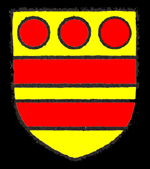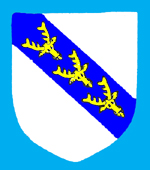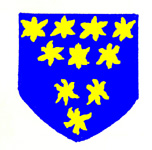Stevington Manor

Wake coat of arms
Early History
The Victoria County History for Bedfordshire, published in 1912, gives a potted history of Stevington Manor, which is first mentioned in the Domesday Book. The manor was part of the large holdings of Eustace, Count of Boulgone in 1086 but by the 1278 the Count of Guînes, not far from Boulogne in the Pas-de-Calais, was the overlord of the manor. After the 13th century the overlordship is no longer mentioned.
The tenant of the manor in 1086 was Arnulf. He came from Ardres, close to Guînes in the Pas-de-Calais, thus two men from the same part of Northern France displaced native Englishmen as controllers of the manor. The Counts of Guînes held the manor as tenants from at least 1153 and, as has been noted above, were also overlords by 1278. Baldwin, Count of Guînes recovered the manor, of which he had been dispossessed by order of the King, in 1205.
By 1253 Roger de Quincy, Earl of Winchester, was tenant. He died without heirs in 1264 and the manor passed to Hadwisa, wife of Baldwin Wake and a daughter of Roger de Quincy's brother Robert. Baldwin Wake died in 1282, leaving a son, John, later Baron Wake of Liddell. He died in 1300 and was succeeded by his two year old son Thomas, later made Governor of Hertford Castle and of the Channel Isles. He died in 1349 and was succeeded by his sister Margaret, wife of Edmund Plantagenet, Earl of Kent. She survived her brother by just a few months and the manor reverted to Wake's wife Blanche, daughter of Henry Plantagenet, Earl of Lancaster who continued to hold the manor until her death in 1381. She was succeeded by her daughter Joan, known as The Fair Maid of Kent who married Thomas de Holand, Earl of Kent and, after his death, Edward the Black Prince, eldest son of Edward III. Her son by Edward became King Richard II (1377-1399).

Holand coat of arms
Dynastic Entanglements
Joan died in 1385 and Stevington was devised to her younger son by Thomas de Holand, John, later (1387) created Earl of Huntingdon and Duke of Exeter (1397). He was executed in 1400 for his part in an intended rebellion against Henry IV to restore his step-brother Richard II, whom Henry had usurped and imprisoned. The family had tangled loyalties, because de Holand's wife was Elizabeth, daughter of John of Gaunt and sister of Henry IV and she regained Stevington Manor after Henry had deprived the family of it following her husband's execution. She died in 1425 and was succeeded by her son John de Holand, who became 2nd Duke of Exeter in 1443.
He died in 1447 and his son Henry succeeded him as 3rd Duke of Exeter. The story of strife which had drawn in his grandfather also affected the 3rd Duke. He fought for his cousin King Henry VI on the Lancastrian side during the Wars of the Roses, losing his titles and estates on the accession of the Yorkist Edward IV in 1461. However, his wife Anne was Edward IV's sister and regained Stevington from her brother! She died in 1476 and as her daughter and heir had already died Stevington reverted to the Crown.
Round Three of Stevington Manor's tangential involvement in national affairs came in 1485 when King Richard III (1483-1485) granted it to Thomas, Lord Stanley. He changed sides at the Battle of Bosworth Field later that year and sealed Richard III's fate. The usurper Henry Tudor, Stanley's step-son, thus became Henry VII (1485-1509) and he made Stanley Earl of Derby in gratitude. His son Edward granted Stevington to the Crown as guarantee for a debt of £5,000 in 1534.

Stanley coat of arms
Later History
The Stanley family continued to hold the manor until 1600 when it was settled on the second husband Thomas Stanley, Earl of Derby. This man was Sir Thomas Egerton, Baron Ellesmere, Lord Chancellor from 1596 to 1617. In 1602 he and his wife alienated the manor to James Dean who, in 1607 conveyed it to Thomas Langhorne and other trustees.
In 1623 Sir Samuel Tryon and Elizabeth, his wife, alienated the manor to George Tuke who, in 1636, conveyed it to William Alston, Lord of the Manor of Odell since 1633. He was a lawyer of Suffolk ancestry who belonged to InnerTemple and was Keeper of Writs in King's Bench, a post of considerable profit and some standing. He was unmarried and the Odell Castle Estate, of which Stevington Manor was, from now on, a part, passed to his brother Thomas, also a lawyer of InnerTemple. He was created a baronet in 1642, the year in which he was High Sheriff of Bedfordshire - also the year in which the First Civil War broke out.

Alston family coat of arms
Thomas' immediate successors were all Baronets and his wife, Elizabeth, was a daughter of Sir Rowland Saint John and thus sister of three successive Lords Saint John of Bletso. Sir Thomas died in 1678 and was succeeded by his younger son Rowland, the elder son having predeceased his father. Sir Rowland died in 1697 and was succeeded by his son Thomas who was one of the Members of Parliament for Bedford Borough from June 1698 to January 1701 and he died, unmarried in 1714. His brother Rowland succeeded him. Sir Rowland sat as a Member of Parliament for Bedfordshire from 1722 until 1741 and died in 1759 aged eighty, his son Thomas succeeding him.
Sir Thomas Alston sat as Member of Parliament for Bedfordshire from 1747 until 1761 and died in 1774. He was the last baronet as his son, also Thomas, was born out of wedlock to a Margaret Lee. Thomas junior inherited the Odell Castle Estate but not the baronetcy which then became extinct. When Thomas junior died in 1823 his son Justinian inherited the estate and his son Crewe succeeded him, dying in 1901 and passing the Odell Castle Estate on to his son Rowland Crewe Alston. On his death in 1933 the estate was sold to Lord Luke.Odell had been, effectively, the fiefdom of the Alston family for almost exactly three hundred years. However, a succession of Law of Property Acts in the 1920s abolished copyhold tenure, manorial fines and, indeed, the concept of manors themselves in all but name.